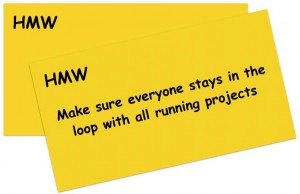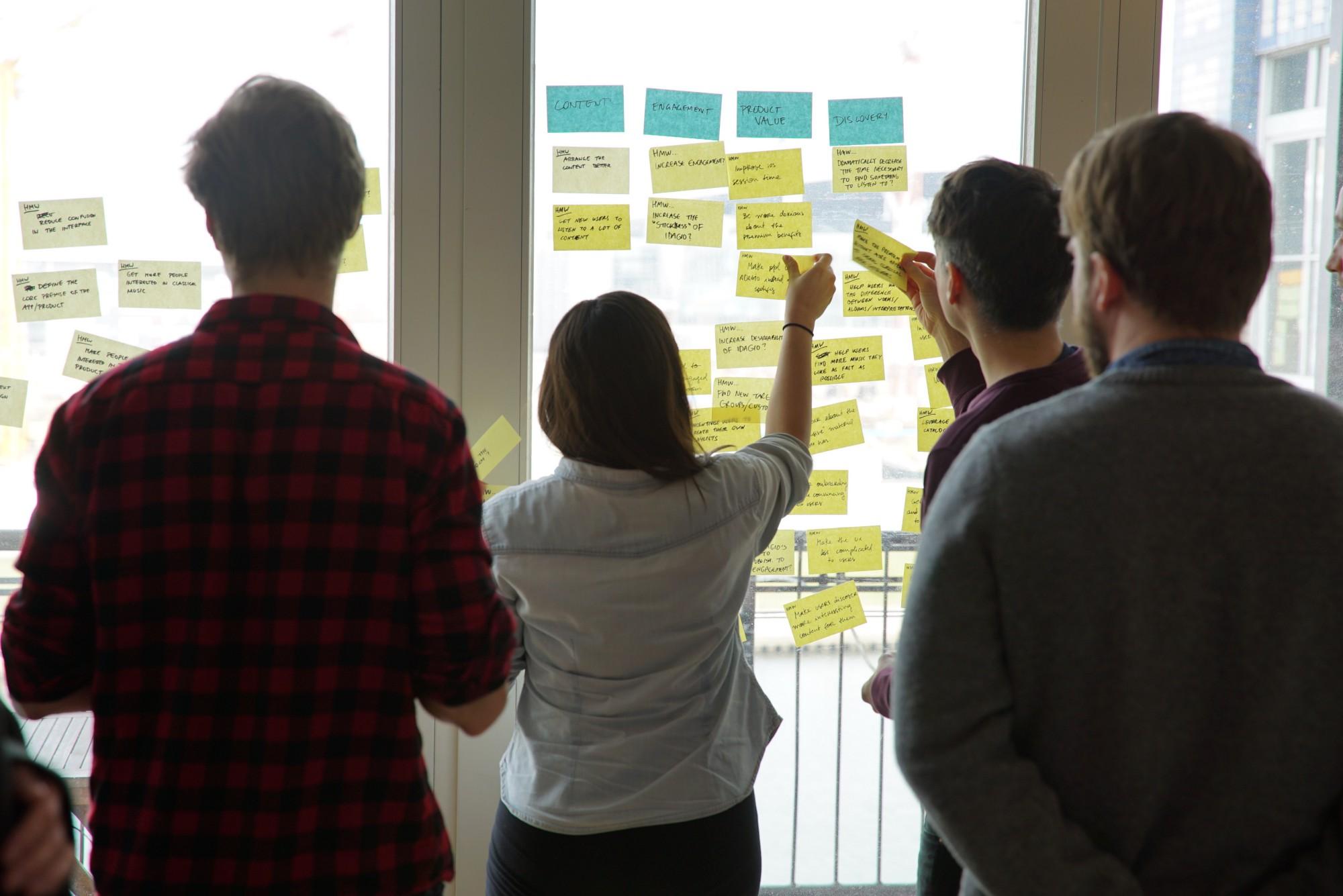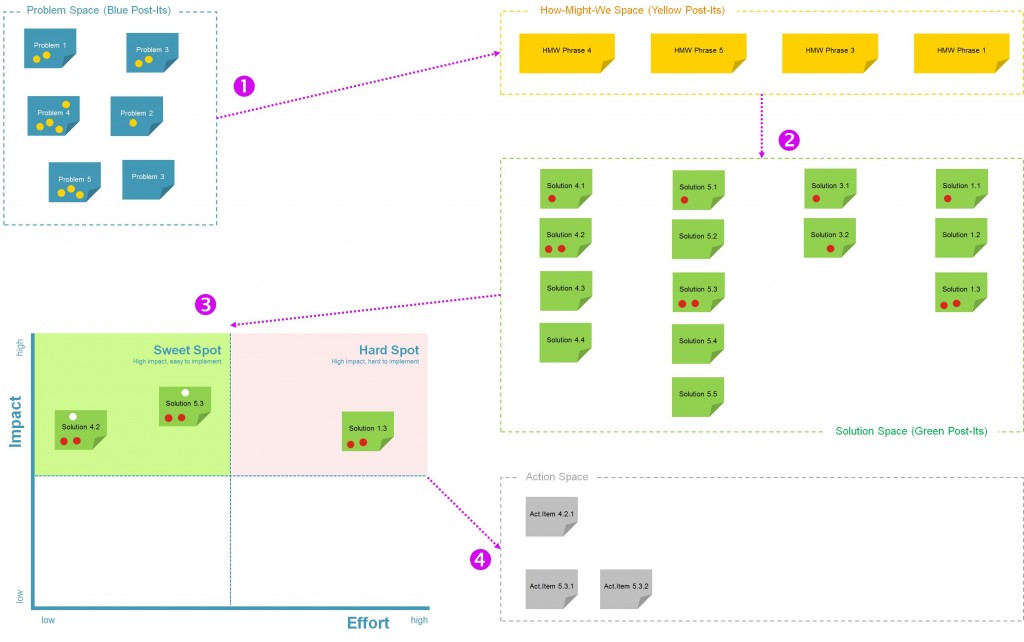Lightning Decision Jam
Main Takeaways
Reading Time: 4 minutes Lightning Decision Jam (LDJ) is a format for group decisioning. All open, unstructured discussion are replaced with a clear, timeboxed structured process. LDJ has its background in design thinking.
Description of Lightning Decision Jam
Meetings are a waste of time. We all know this. The discussion starts as a lion and ends as rabbit fur. Why?
People tend to discuss!
Lightning Decision Jam (LDJ) is a format for group decisions. All open, unstructured discussions are replaced with a clear, time-boxed structured process. LDJ has a background in design thinking.
Rules of Lightning Decision Jam
Select a Moderator.
- Start with the Problems – 7 min.
Each participant spends 7 minutes without discussion writing on blue post-its all the challenges, annoyances, mistakes or concerns that happened during the week.
- Present Problems – 4 min per person
One person at a time to stand up at a wall/whiteboard to very quickly explain each problem as they stick them to the surface (max 30 sec per post-it). Nobody else in the team is allowed to speak here. - Select Problems to Solve – 6 min
Each member gets 2 voting dots. – Everybody must now vote on the problems they consider to be the most pertinent to solve, without discussion. - Reframe Problems as Standardised Challenges – 6 min
(Reformat problems to the standardised HMW-pattern: “How Might We <improve X>”)Only focus on the voted and prioritised problems. The moderator rewrites on yellow post-its each one as a standardised How-Might-We challenge. This will help to create an array of solutions and be a little bit broader at the start.
This will help to create an array of solutions and be a little bit broader at the start. - Produce Solutions – 7 min
Use the top-voted HMW challenges to produce solutions. If there are two top-voted challenges, or three just start with the one on the left first. Don’t worry about it and do not discuss it!
Each participant gets 7 minutes to write on green post-its as many possible ways to tackle the HMW challenge without any discussion. Removing discussion here also insures a variety of solutions. It’s important for the moderator to tell the team members here that we’re aiming for Quantity over Quality – Later we can curate.
Solutions don’t have to be written in any particular way – but they must be understandable to people reading. There is no individual presenting of solutions as this creates a bias towards the best presenters.
Once the 7 minutes is up – everybody sticks their ideas on the surface (wall, whiteboard, whatever) as fast as possible. This should only require one minute. - Vote on Solutions – 10 min
The moderator now gives each participant six dots to vote on the solutions they think would best solve the HMW. Because the participants will need to read each post-it, a little more time is given for this voting process. - Prioritise Solutions – 30 Seconds
Just like we did with the problems, the participants now have 30 seconds to make a prioritised list of solutions. – Ignore anything with less than two votes. - Decide what to execute on – 10 min
It is clear that some solutions are more popular than others to test out, but it's important to know how much effort is required to execute the solutions – so here we use a simple effort/impact scale to determine which solutions to try ASAP, and which should be added to a to-do list, or however you store your backlog.
The moderator needs to be very proactive at this step, as she is the only one that has a tendency to open up discussion. The Moderator will now take each solution one by one and add them to the effort/impact map. The effort, in this case, is how much effort the participants think it will take to implement and the impact is the degree to which they think it would solve the problem.
So here’s what the moderator needs to do: Take the top-voted solution, hover it over the centre of the E/I scale and simply ask “higher or lower” – usually some small discussions break out here, so the moderator has to be diligent in finding a consensus and stopping any conversations extending past 20 seconds. Once the effort has been determined, the moderator uses the same drill for impact: “Higher or Lower.”
The moderator should now quickly mark all post-its in the sweet spot with a contrasting dot so we can identify them later. - Turn Solutions into Actionable Tasks – 5 min
The moderator now takes the “Sweet Spot” solutions off the E/I map and asks the person who wrote the solution to give actionable steps toward testing the solution. By “actionable” is meant something that can be executed in a timeframe of 1–2 weeks. The rule of thumb is a 1-week experiment, but of course, this will depend on what the solution entails.
Once all these solutions are written up, the participants now have actionable tasks that can be committed to. The solutions that didn’t make it into the “Sweet Spot” are moved to the backlog so they don’t get forgotten.
The following picture shows the complete workflow.
Materials Needed
- Rectangular post-its, yellow
- Square post-its (2 different colours, green and blue)
- Voting dots, 2 different colours
- Sharpies or something similar
- Time Timer or any timer that Clearly shows the remaining time
- A nice playlist of focus music (Jonathan Courtney, AJ&Smart created one)
When to use Lightning Decision Jam
- The issues have to be solved fast.
- The issues are not too difficult - they might be complicated but not complex (in the Cynefin sense).
- The participants tend to have an endless discussions.
- The participants have a rough understanding of the issues.
- There is only a very short time.
Facilitator Role
- Has to stop upcoming all discussions between participants immediately.
- Supports the participants in a conflict-free and appreciative discussion process.
- Rewrites the problems to HWM challenges
- Feeds the Effort/Impact map.
Further Reading
- Jonathan Courtney: Lightning Decision Jam — Solve Problems Without Discussion, Medium 29. Mar. 2017,
- Jonathan Courtney: Lightning Decision Jam , SessionLab Facilitation Library,
- Jonathan Courtney: Lightning Decision Jam , YouTube.
Acknowledgement
Method proudly stolen from: Jonathan Courtney, AJ&Smart, Berlin.
: Jonathan Courtney, AJ&Smart via medium.com • Michael Tarnowski, Plays-in-Business.com, .








Leave A Comment